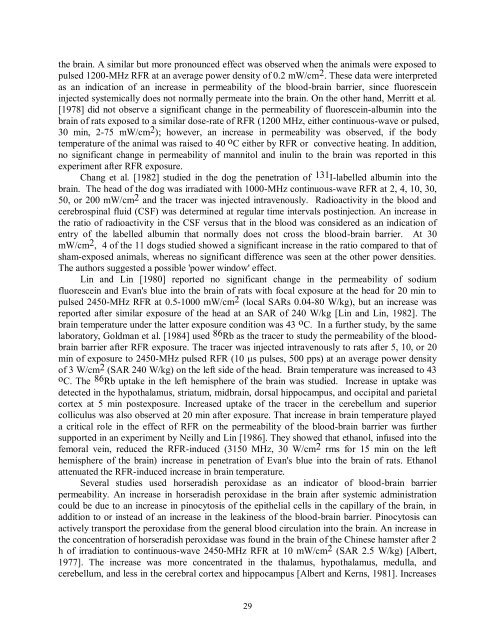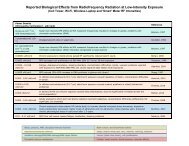Evidence for Effects on Neurology and Behavior - BioInitiative Report
Evidence for Effects on Neurology and Behavior - BioInitiative Report
Evidence for Effects on Neurology and Behavior - BioInitiative Report
You also want an ePaper? Increase the reach of your titles
YUMPU automatically turns print PDFs into web optimized ePapers that Google loves.
the brain. A similar but more pr<strong>on</strong>ounced effect was observed when the animals were exposed to<br />
pulsed 1200-MHz RFR at an average power density of 0.2 mW/cm 2 . These data were interpreted<br />
as an indicati<strong>on</strong> of an increase in permeability of the blood-brain barrier, since fluorescein<br />
injected systemically does not normally permeate into the brain. On the other h<strong>and</strong>, Merritt et al.<br />
[1978] did not observe a significant change in the permeability of fluorescein-albumin into the<br />
brain of rats exposed to a similar dose-rate of RFR (1200 MHz, either c<strong>on</strong>tinuous-wave or pulsed,<br />
30 min, 2-75 mW/cm 2 ); however, an increase in permeability was observed, if the body<br />
temperature of the animal was raised to 40 o C either by RFR or c<strong>on</strong>vective heating. In additi<strong>on</strong>,<br />
no significant change in permeability of mannitol <strong>and</strong> inulin to the brain was reported in this<br />
experiment after RFR exposure.<br />
Chang et al. [1982] studied in the dog the penetrati<strong>on</strong> of 131 I-labelled albumin into the<br />
brain. The head of the dog was irradiated with 1000-MHz c<strong>on</strong>tinuous-wave RFR at 2, 4, 10, 30,<br />
50, or 200 mW/cm 2 <strong>and</strong> the tracer was injected intravenously. Radioactivity in the blood <strong>and</strong><br />
cerebrospinal fluid (CSF) was determined at regular time intervals postinjecti<strong>on</strong>. An increase in<br />
the ratio of radioactivity in the CSF versus that in the blood was c<strong>on</strong>sidered as an indicati<strong>on</strong> of<br />
entry of the labelled albumin that normally does not cross the blood-brain barrier. At 30<br />
mW/cm 2 , 4 of the 11 dogs studied showed a significant increase in the ratio compared to that of<br />
sham-exposed animals, whereas no significant difference was seen at the other power densities.<br />
The authors suggested a possible 'power window' effect.<br />
Lin <strong>and</strong> Lin [1980] reported no significant change in the permeability of sodium<br />
fluorescein <strong>and</strong> Evan's blue into the brain of rats with focal exposure at the head <str<strong>on</strong>g>for</str<strong>on</strong>g> 20 min to<br />
pulsed 2450-MHz RFR at 0.5-1000 mW/cm 2 (local SARs 0.04-80 W/kg), but an increase was<br />
reported after similar exposure of the head at an SAR of 240 W/kg [Lin <strong>and</strong> Lin, 1982]. The<br />
brain temperature under the latter exposure c<strong>on</strong>diti<strong>on</strong> was 43 o C. In a further study, by the same<br />
laboratory, Goldman et al. [1984] used 86 Rb as the tracer to study the permeability of the bloodbrain<br />
barrier after RFR exposure. The tracer was injected intravenously to rats after 5, 10, or 20<br />
min of exposure to 2450-MHz pulsed RFR (10 s pulses, 500 pps) at an average power density<br />
of 3 W/cm 2 (SAR 240 W/kg) <strong>on</strong> the left side of the head. Brain temperature was increased to 43<br />
o C. The 86 Rb uptake in the left hemisphere of the brain was studied. Increase in uptake was<br />
detected in the hypothalamus, striatum, midbrain, dorsal hippocampus, <strong>and</strong> occipital <strong>and</strong> parietal<br />
cortex at 5 min postexposure. Increased uptake of the tracer in the cerebellum <strong>and</strong> superior<br />
colliculus was also observed at 20 min after exposure. That increase in brain temperature played<br />
a critical role in the effect of RFR <strong>on</strong> the permeability of the blood-brain barrier was further<br />
supported in an experiment by Neilly <strong>and</strong> Lin [1986]. They showed that ethanol, infused into the<br />
femoral vein, reduced the RFR-induced (3150 MHz, 30 W/cm 2 rms <str<strong>on</strong>g>for</str<strong>on</strong>g> 15 min <strong>on</strong> the left<br />
hemisphere of the brain) increase in penetrati<strong>on</strong> of Evan's blue into the brain of rats. Ethanol<br />
attenuated the RFR-induced increase in brain temperature.<br />
Several studies used horseradish peroxidase as an indicator of blood-brain barrier<br />
permeability. An increase in horseradish peroxidase in the brain after systemic administrati<strong>on</strong><br />
could be due to an increase in pinocytosis of the epithelial cells in the capillary of the brain, in<br />
additi<strong>on</strong> to or instead of an increase in the leakiness of the blood-brain barrier. Pinocytosis can<br />
actively transport the peroxidase from the general blood circulati<strong>on</strong> into the brain. An increase in<br />
the c<strong>on</strong>centrati<strong>on</strong> of horseradish peroxidase was found in the brain of the Chinese hamster after 2<br />
h of irradiati<strong>on</strong> to c<strong>on</strong>tinuous-wave 2450-MHz RFR at 10 mW/cm 2 (SAR 2.5 W/kg) [Albert,<br />
1977]. The increase was more c<strong>on</strong>centrated in the thalamus, hypothalamus, medulla, <strong>and</strong><br />
cerebellum, <strong>and</strong> less in the cerebral cortex <strong>and</strong> hippocampus [Albert <strong>and</strong> Kerns, 1981]. Increases<br />
29



